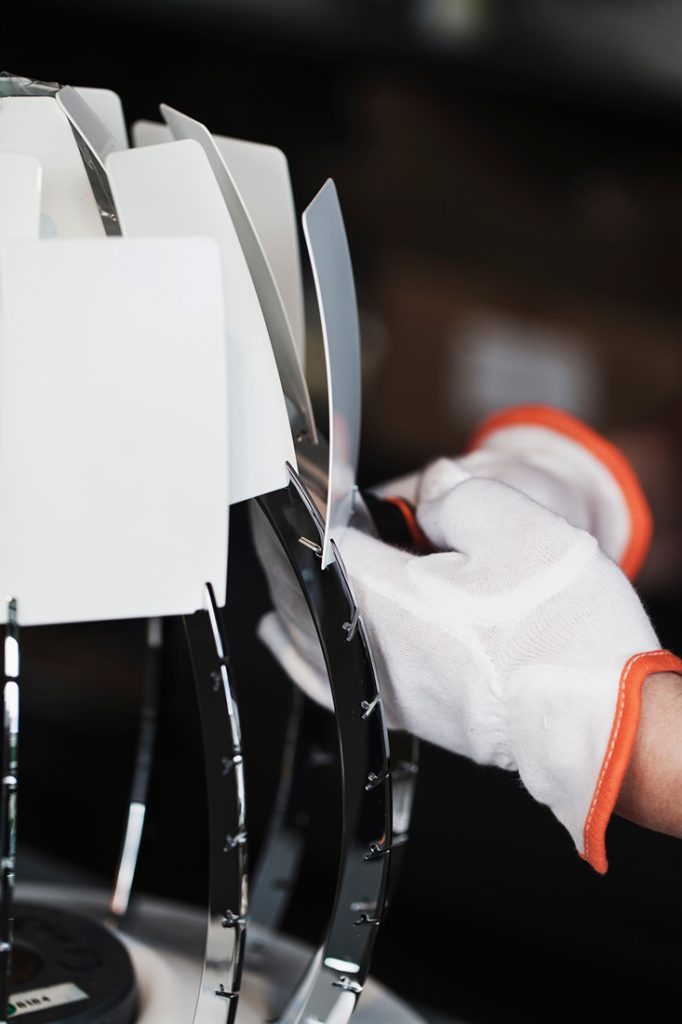Louis Poulsen’s lights are designed with a core consideration for human experience. And the presence of human hands in their production enhances that quality.

Louis Poulsen factory in Vejen, Denmark
October 26th, 2018
We are now many centuries from the times when human labour was the basis of production. Today it is, ironically, the signpost of a special approach. At a time when robotics are infiltrating factories at record-breaking rates, it’s significant if a manufacturer chooses to retain human-driven processes and continue the meeting of hands, materials and tools.
The presence of human minds, eyes and hands all the way through the manufacturing process has an effect on the object that results. Human work has human-centric effects, becoming part of the story of the object. The human-driven approach speaks volumes about qualitative value. It signifies an investment in time and a concern for detail. In essence, it illustrates the valuing of skills and the craft of making.
Louis Poulsen’s continued focus on the human-led production of its lights is an unquestioned constant. This is, after all, a brand whose products are designed with human experience at their core. And at its anniversary celebrations for three iconic Poul Henningsen lights during the 3 Days of Danish Design festival in May, the Louis Poulsen showroom on Gammel Strand was transformed into a showcase for its hand-assembly processes.
The Louis Poulsen Makery, as the set up was called, celebrated the making of the PH Artichoke and other lights, bringing production staff and their hand tools out of the factory and into direct contact with showroom guests. It was a fitting way to mark the sixtieth anniversary of PH Artichoke, which was designed back in 1958 by Poul Henningsen for Langelinie Pavillonen – a modernist Copenhagen restaurant where it still hangs today.

The Louis Poulsen Makery
Crafting continues at Louis Poulsen, and much of the production process for PH Artichoke is still done by hand. The 72 punched brass, copper or steel leaves that create its sculptural form (laser cut in the case of the stainless steel version) are brushed and coated by hand. Each leaf is given its breathing space on drying racks before being inspected, cleaned and stacked between foam spacers to await assembly. Human-operated presses stamp the metal components and the round top plates are spun into shape with the application of pressure by hand.
At The Louis Poulsen Makery, guests were invited to observe the assembly of the leaves on the chrome-plated steel frame of PH Artichoke. Slotted in one by one, the leaves are held in position by short wires, each bent by the maker with pliers to ensure secure placement. There’s no adhesive in sight. What is visible, however, is the gradual materialisation of a perfected form – a symphony of metal that, thanks to Henningsen’s mastery, provides glare-free light from any angle.

The Louis Poulsen Makery
A sixtieth-anniversary brushed brass edition of PH Artichoke is available between September and December 2018, and its significance is marked by the inclusion of an anniversary engraving on the third row of leaves from the top. It presents Henningsen’s own signature, then reads: “PH Artichoke – 1958-2018 – Anniversary Edition” followed by a unique number. Collectors can rest assured that the engraved leaf was placed by experienced hands, who carry on a production process that has defined the PH Artichoke for 60 years.
Photos of The Louis Poulsen Makery and factory by Marie Louise Munkegaard.
A searchable and comprehensive guide for specifying leading products and their suppliers
Keep up to date with the latest and greatest from our industry BFF's!

BLANCO launches their latest finish for a sleek kitchen feel.

Vert, an innovative demountable pergola designed for urban greening, is reshaping the way we think about sustainability in urban architecture.

In this candid interview, the culinary mastermind behind Singapore’s Nouri and Appetite talks about food as an act of human connection that transcends borders and accolades, the crucial role of technology in preserving its unifying power, and finding a kindred spirit in Gaggenau’s reverence for tradition and relentless pursuit of innovation.

To honour Wilson Architects’ storied legacy, the practice has released a tome titled Genius Loci.

The venerable Danish brand mark their long history with a suite of modern heirlooms.
The internet never sleeps! Here's the stuff you might have missed

In this New Zealand workplace design by Wingates, Anthony Harper were “keen to evolve their working environment as the world evolves as well.”

The $160 million transformation of 500 Bourke Street in Melbourne’s CBD has revitalised a 1970s Brutalist icon, originally designed by Godfrey & Spowers.